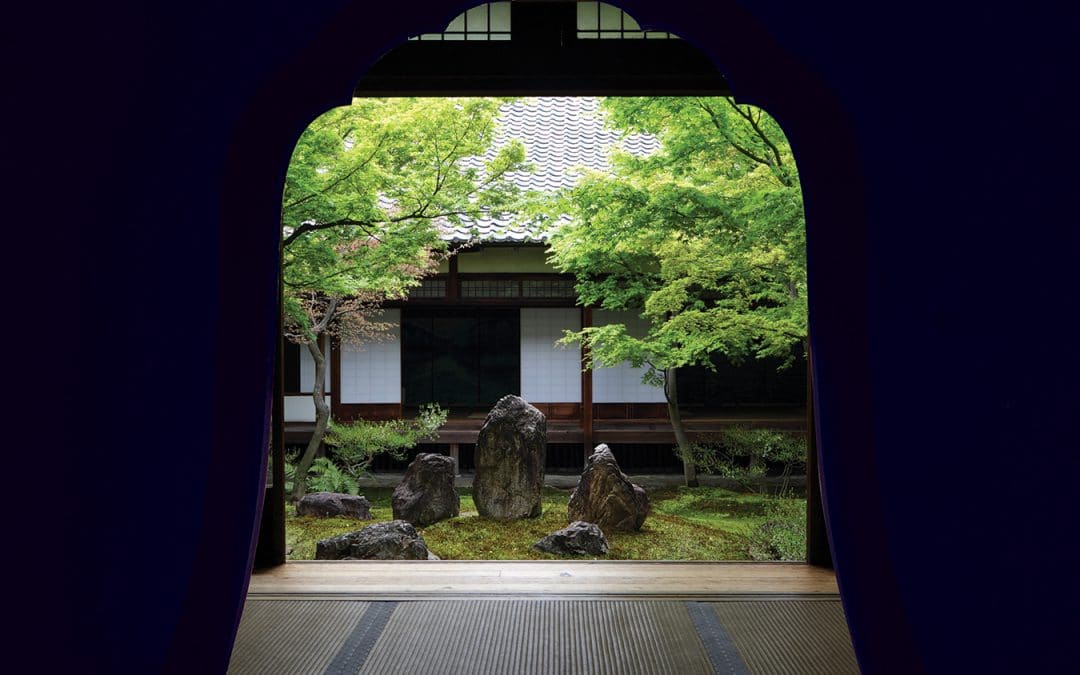What is Zen Buddhism?
Living in the present. Zen is not a theory, dogma or religion, but a practical experience that leads to spiritual awakening. Generally, it centers around concentration and responsibility within oneself, coupled with compassion in day-to-day life, without the presence of a deity. The practice can be applied to the way that we work, interact with friends and family, create the space around us, or what we decide to eat.
Zen Buddhism, a form of Mahayana Buddhism from China, was introduced to Japan in the 12th century. Buddhism itself began in what is now Southern Nepal, 2,500 years ago with Siddhartha Gautama. He was a wealthy prince, who became aware of the true suffering of his people and sought understanding. After years of studying and wandering, he reached enlightenment or “nirvana” meditating under a bodhi tree. He is now known as The Buddha (“The Awakened One”).
The main principle of Buddhism is that life is suffering, called the “suffering of existence,” and the root of all suffering is attachment. In Western culture, we cling onto things and let ego drive how we perceive our lives. Whether it be relationships, physical possessions, money or fear—attachment can consume thoughts and lead to the inability to truly reach our full potential. Buddhism teaches impermanence; that everything in life is ever-changing and that clinging to things that will change leads to suffering. Zen Buddhism centers around “zazen” or seated meditation. This method is unique to Zen, as it focuses solely on breathing and good posture, and it is used to accept impermanence in order to achieve relief from suffering. Generally, Zen Buddhists sit on a cushion, or “zabuton/zabu” and meditate for around 15 minutes at a time.
Breathe
There are many breathing techniques that can be used while meditating. The 4-7-8 breathing pattern consists of drawing a breath in to the count of four seconds, holding the breath for seven seconds and releasing to the count of eight. Repeat this cycle, concentrating on the movement of filling and emptying your lungs completely. Correct breathing is vital to centering oneself and establishing a meaningful meditation routine. You can find the best breathing pattern to help you calm your body and enter a state of meditation.
Sit Like the Lotus
The lotus is significant to Buddhism because its roots grow in muddy water, yet the flower’s bloom floats gracefully on top of the water, which symbolizes a rise above the suffering. A proper sitting position should resemble a lotus flower. Most Buddhists sit on a pillow or soft mat and cross their legs over or under each other, placing one hand on top of the other loosely in their lap, palms up. You can find the most comfortable style for you. Maintain a straight neck and back, close your eyes and begin your breathing. Zen’s goal is to think of nothing, just your breath and undisturbed posture, like the lotus.
Strengthen Your Mind
The art of nothingness can be difficult to master. When you feel like you can’t Zen, remember that just like any new skill, practice makes… good. A mindful meditation experience allows for cognizant healing to begin by quieting the ego-driven conscious and discovering the unconscious. As you learn to control your breathing, you will enter into a meditational state where thoughts may drift across your mind. Acknowledge them kindly but don’t visit with them. Send them on their way out of your psyche. After a while, intrusive thoughts will appear less often. When your mind is completely quiet, this is called “no-mind;” inside and outside are one and you are in the now.
Finding Space
Living Zen goes beyond mediation. The way and where you spend your time can contribute significantly to mindfulness. Zen gardens consist of carefully placed natural elements to provide a serene, quiet place to reflect. Zen gardening’s oldest art form is karesansui or “dry-landscape.” Gravel or sand is raked to mimic the look of flowing water. Rocks, bushes and other elements are placed to represent stillness and peace of mind. Hill gardens use water and colorful plants to create a tranquil setting. Pathways symbolize The Buddha’s path. Plants, water, bridges and other materials provide splendor to the onlooker from multiple angles. Finding a space, whether it be walking in the woods, visiting the beach, or creating your own restful zone within your home, can help keep your thoughts clear and lower your stress level. You can visit Japanese gardens for yourself right here in the Aomori Prefecture. The Seiryu Temple, outside of Aomori City, is home to the “Big Buddha” statue. The grounds have manicured green gardens and delicate, swept sands. It is a place of harmony in the warm or cold months.
Mastering Zen
Zen masters teach Koan: a paradoxical riddle that’s impossible to solve logically. Trying to form a solution mindfully is a way to build intuition in order to break through ego and discover genuine essence. Sometimes in life there are no solutions, only acceptance. Think of current obstacles you may be facing. Instead of dwelling on these stressors, gracefully accept what you can do and what you cannot do. This is Zen living. Since the 1980s, Zen Buddhism has begun to take foothold in Western culture, as more people are coming to understand that body and mind connectivity is important to overall spiritual contentment. With a little practice, we can all find our Zen. If you’d like to learn more about Zen or other variations of Buddhism practices, visit the Overstreet Memorial Library, where they have a selection of books on these subjects.


